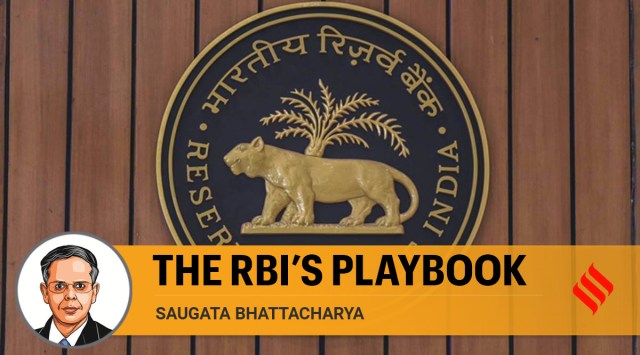- India
- International
The RBI’s playbook: Further interest rate hikes are expected, albeit more calibrated
Saugata Bhattacharya writes: The expected narrowing differential with US interest rates is one of the reasons the rupee is likely to remain volatile for some time. This will require the MPC to use specific instruments for targeting multiple objectives in order to achieve desired outcomes at minimum economic cost
 India’s external “financial conditions” are likely to remain tight in the foreseeable future. (File Photo)
India’s external “financial conditions” are likely to remain tight in the foreseeable future. (File Photo)As expected, the members of the monetary policy committee have voted to increase the repo rate by 50 basis points to 5.9 per cent. One member voted for a more moderate increase of 35 basis points. The stance of the policy continues to be (as in the August meeting) “focused on withdrawal of accommodation”, indicating the continuing primacy of moderating inflation (price stability) and hence further rate hikes.
The average CPI inflation forecast has been retained at 6.7 per cent for 2022-23, with risks evenly balanced (higher rice and pulses and lower oil and metals prices). However, the GDP growth forecast has come down to 7 per cent (from the earlier assessment of 7.2 per cent) after the slightly weaker than expected first quarter print of 13.5 per cent.
Monetary policy is now entering a phase that will require a coordinated approach of interest rates, liquidity and exchange rate responses as RBI’s decision making will operate in the “impossible trinity of open economy macroeconomics” — that is, the inability to independently determine domestic interest rates when the exchange rate is market determined and the capital account is open.
India’s external “financial conditions” are likely to remain tight in the foreseeable future. The US Federal Reserve will continue to raise its policy rate in a methodical manner to tame inflation, as strong aggregate demand is reinforced by a tight labour market. The current view on the extent of further Fed rate hikes is likely to be understated, since monetary policy transmission is relatively weak in the US — it has a large home loan stock largely priced at long-term fixed interest rates and hence relatively insensitive to policy rate changes. Hence, it is reasonable to assume that the dollar will remain strong in the near future.
Europe, in contrast, is having to resort to various fiscal and administrative measures to mitigate the impact of soaring energy prices on household consumption. Some central banks have responded by warning of more aggressive tightening to offset these expansionary fiscal measures. In addition, China’s growth slowdown — due to various structural weaknesses and policy restrictions — is reflected in a depreciating currency, which is also likely to have an impact on other Asian emerging markets exchange rates.

What does this imply for monetary policy in India? One, that MPC actions will still be determined by domestic inflation, growth and broader financial conditions. However, second order effects from the global policy spillovers and the broader expected economic slowdown are bound to influence domestic conditions through financial, commodities and trade channels.
India’s aggregate demand (hence the growth momentum) remains surprisingly resilient, even after cumulative repo rate hikes of 140 bps since early May (excluding this hike). Direct tax collections remain strong, indicating inter alia corporate financials’ strength. GST collections (as well as trends in e-way bills) suggest strong economic activity. Manufacturing and Services Purchasing Managers Indexes (PMIs) show strong order books. Manufacturing capacity utilisation was at a three-year high in the first quarter of this year — evidence of a closing “output gap”. Further, non-oil and gold imports also remain robust.
At the same time, CPI inflation is likely to remain elevated during 2022-23, although peaking in September. While much of this will be the result of food prices, even core inflation is likely to remain persistently high, averaging 5.9 per cent in the second half of the year. Household inflation expectations had thus far remained reasonably anchored, but the three-month ahead print had risen by 50 basis points in the RBI’s September survey. Inflation expectations are very important for central bankers since any un-anchoring after persistent high price shocks carries the risk of spilling over into wage negotiations. In India, there are signs of increasing labour demand in certain skills segments, and higher wage increases could amplify aggregate demand and price pressures.
Based inter alia on this growth-inflation scenario, we still expect the peak (“terminal”) repo rate in this tightening cycle to be around 6.5 per cent, based on real (inflation adjusted) “natural rates” suggested by RBI analytics and a one-year ahead inflation forecast of 5 per cent (given that monetary policy is calibrated over a one-year horizon). RBI remains reluctant, and for good reason, about providing forward guidance on this, given the “highly uncertain” and rapidly evolving global market conditions. But it is reasonable to expect that repo rate hikes are likely to be more calibrated from now on, depending on the evolving inflation-growth dynamics, rather than the largely front-loaded rate actions since May.
As much as rate actions, management of system liquidity will be central to guiding short-term, money market interest rates, which determine the cost of funds for financial intermediaries, and hence (the non-repo rate benchmarked) lending rates. RBI has used liquidity measures to guide these short-term rates upwards since October last year with a steady hand, implementing a de facto “removal of accommodation” much before the formal start of tightening. This started with the narrowing of the lower bound of the policy rate corridor in April, before starting with the repo rate increases in early May. Hence, effective tightening has been larger, with market interest rates rising much more than the 190 basis points increase in the repo rate. This reduces the financial risks of the narrowing policy interest rate gap with the Fed rate.
Yet, the expected narrowing differential with US interest rates is one of the reasons the rupee is likely to remain volatile for some time. The art of monetary policy is using specific instruments for targeting multiple objectives in order to achieve desired outcomes at minimum economic cost. While an interest rate defence is a textbook response to a depreciating currency, this is too broad an instrument. RBI (in coordination with the government) has an extensive playbook of measures to modulate foreign currency flows – these are likely to be progressively deployed. Like in the past, adroit use of policy choices can be expected to minimise the “growth sacrifice ratio” while guiding inflation down gradually over the next couple of years towards the target of 4 per cent.
The writer is Executive Vice President and Chief Economist, Axis Bank. Views are personal
EXPRESS OPINION
More Explained
Apr 20: Latest News
- 01
- 02
- 03
- 04
- 05









































